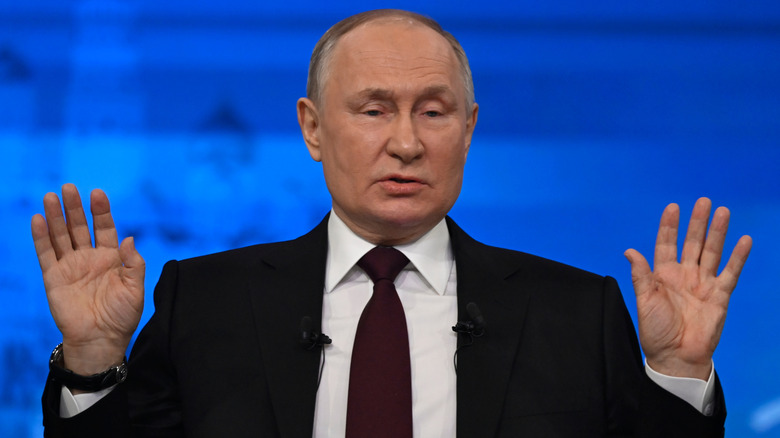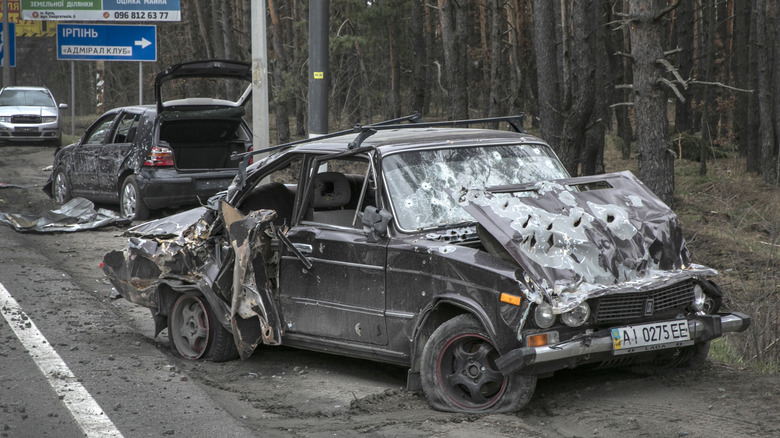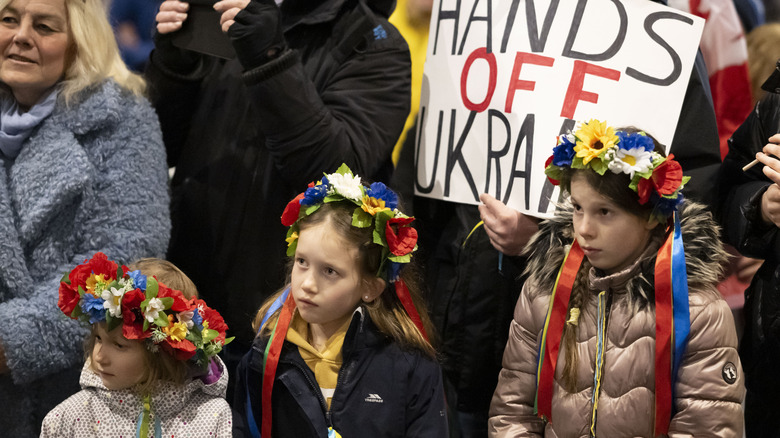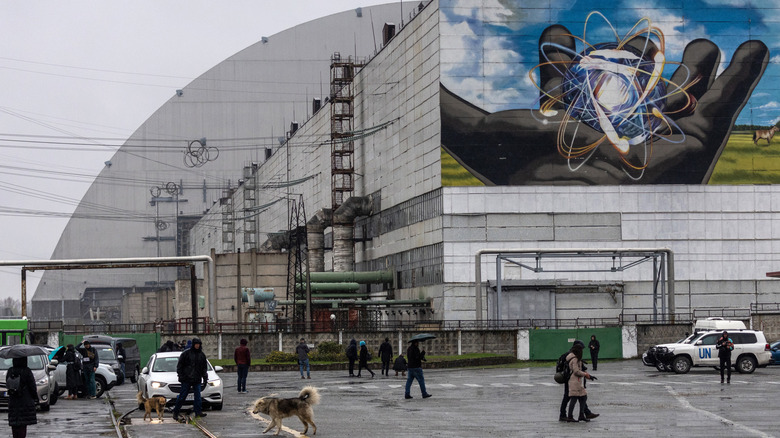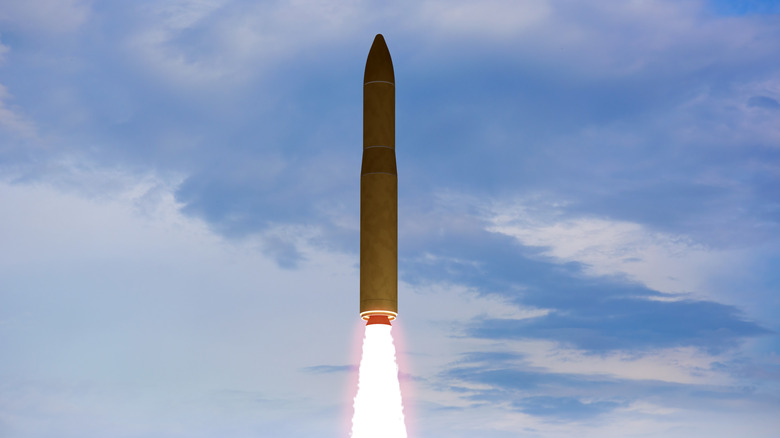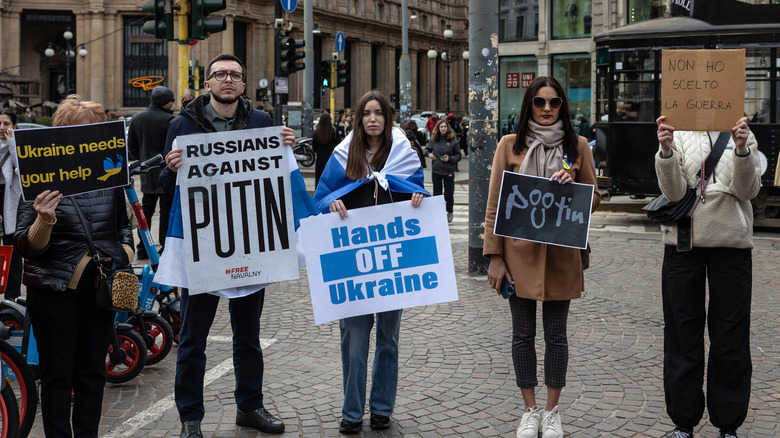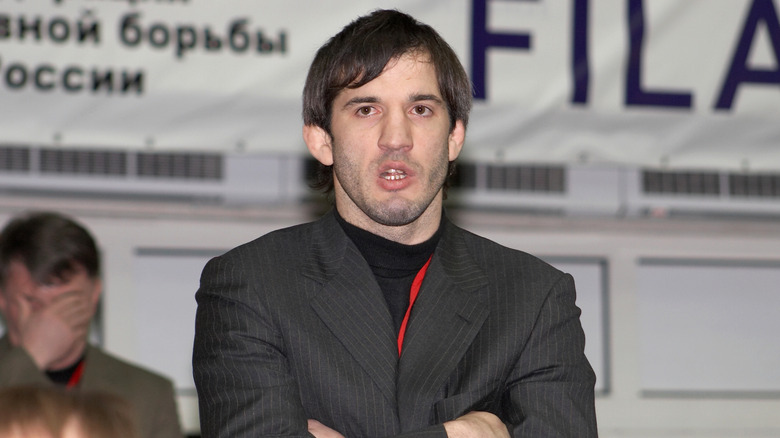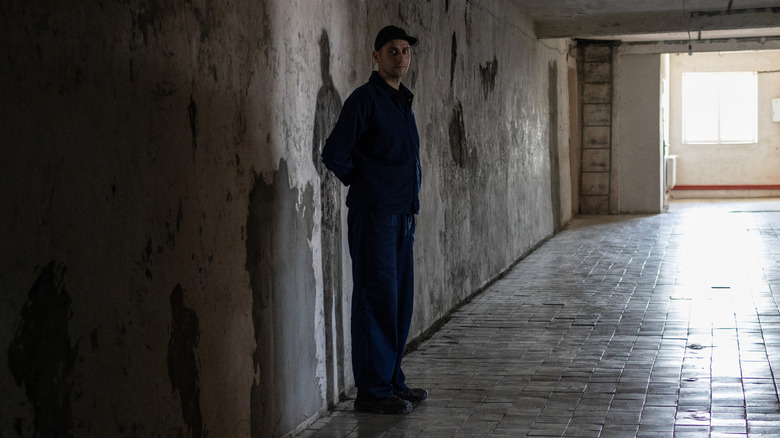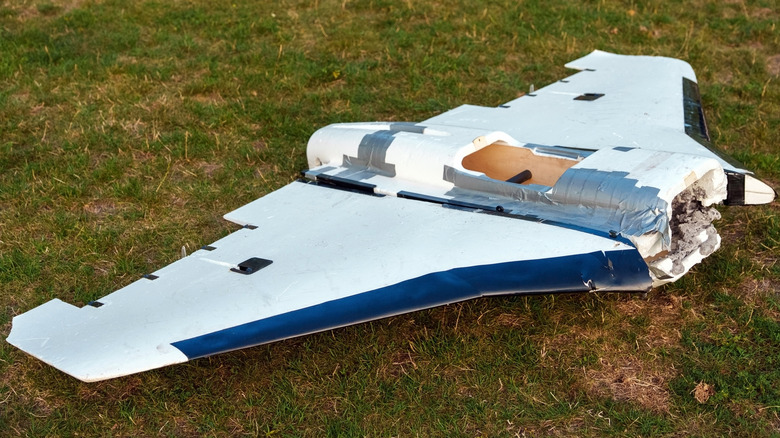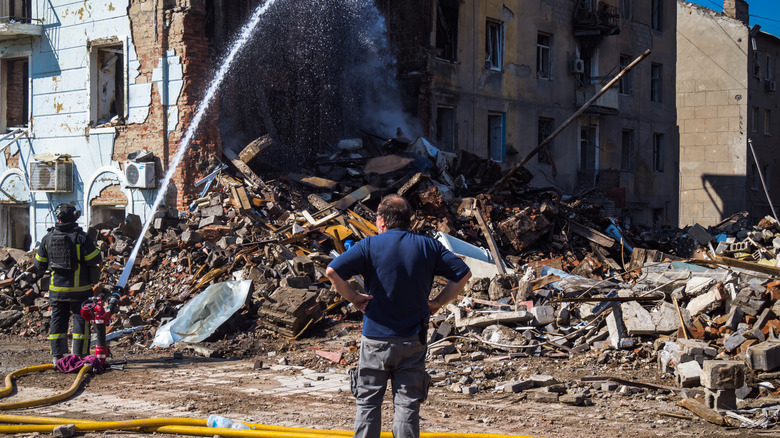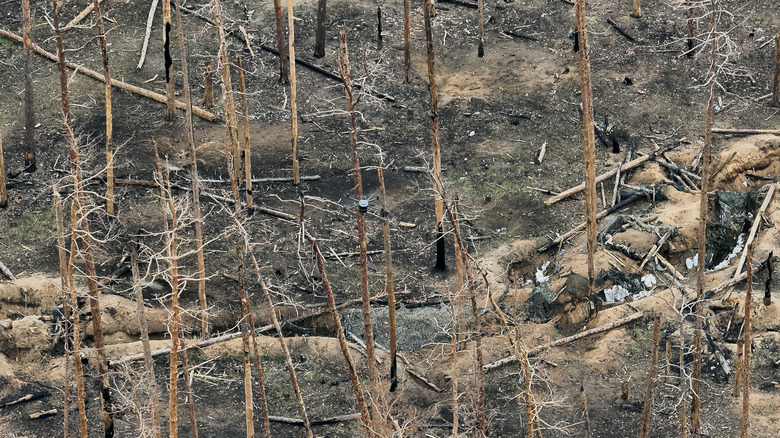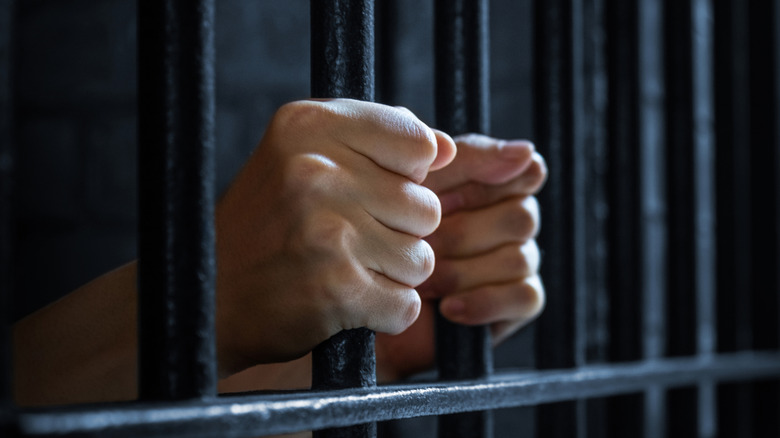Why The Russia-Ukraine War Is Worse Than You Think
Since Russia's invasion of Ukraine on February 24, 2022, the war between the two countries has now run for over 1,300 days as of this writing. There are many tragic details about the last time Russia invaded Ukraine, which marked the beginning of the years-long conflict, and the damage resulting from the ongoing Russia-Ukraine war (mostly affecting the latter country) is already immense and widely documented.
There are, of course, the statistics that any observer would expect to hear. For starters, the combined military casualty toll is staggering. As of April 2025, the Russian side reportedly had nearly 800,000 killed or injured and around 50,000 personnel unaccounted for. Ukraine reported high losses as well: 400,000 deaths or injuries and 35,000 missing as of January 2025. In Ukraine, over 1,762 attacks on healthcare workers and facilities have been recorded as of February 2025, and numerous religious structures, residential buildings, and schools have been destroyed or damaged. Then there's the massive economic cost of war for both sides. While Ukraine's economy has undoubtedly suffered immensely, Russia has also been stung with sanctions from the United States, the European Union, and other nations seeking to end the war. Worse, millions of people's lives have been uprooted: As of September 2025, about 3.8 million remain internally displaced within Ukraine, and at least 5.7 million have crossed borders as refugees.
Yet the reality is even harsher than such figures suggest, and these commonly understood horrors represent only the visible tip of a far more destructive conflict with lasting — perhaps tragically, permanent — consequences.
The Bucha massacre
It's a tragic fact that during wartime, people die, many of whom are innocent and have no direct stake or involvement in the conflict. And among the many horrific repercussions of war, the wanton loss of life is one that no one should ever get desensitized to, especially when the extent of the carnage is on full display. From early March until March 31, 2022, Russian forces occupied the city of Bucha, northwest of Kyiv. After their withdrawal, grisly photos and videos were published in early April, showing numerous civilian bodies, massive property destruction, and a trench at the Church of St. Andrew and Pyervozvannoho All Saints used for burials. Satellite images from March 18 and 19 (which was within the period that the city was under Russian control) seemed to show at least one street strewn with bodies.
Four months after Russian withdrawal, Ukrainian authorities reported a total of 458 bodies recovered in Bucha, including nine children. Four-hundred-and-nineteen showed signs of gunshot wounds, torture, or other violent trauma, and 39 deaths were attributed to natural causes potentially linked to occupation conditions. There was also a bag full of remains belonging to different people, and the town's mayor told The Washington Post the body parts were "too fragmented, decomposed, or badly mutilated to be identified." Over the last three years, investigations from the Ukrainian government, international monitoring organizations, and independent media have reportedly uncovered evidence pointing to Russian forces being responsible for the detentions and executions of civilians. But Russia has consistently denied responsibility for what transpired in Bucha.
Ukrainian children illegally relocated to Russia
Since the beginning of the Russia-Ukraine War, multiple investigations have documented an alleged program involving the transfer of Ukrainian children to the Russian Federation or to Russian-occupied territory, followed by "re-education," changes of guardianship, and, in some cases, adoption and expedited citizenship under Russian procedures. The Ukrainian government cites more than 19,500 identified cases of children deported or forcibly displaced. Meanwhile, the Yale Humanitarian Research Lab describes a network of "at least" 57 facilities inside Russia and occupied Ukraine used to hold or process an estimated 8,400 Ukrainian children. Inside, activities have reportedly included ideological instruction, patriotic and military training (which has included singing the Russian national anthem), and steps to place some children for adoption with Russian families.
On March 17, 2023, the International Criminal Court issued arrest warrants for Russian president Vladimir Putin and Commissioner for Children's Rights Maria Lvova-Belova for the alleged "unlawful deportation of population (children) and the unlawful transfer of population (children) from occupied areas of Ukraine to the Russian Federation." The European Parliament also filed a motion of resolution demanding the return of the deported children, describing their transfer and indoctrination as actions that can be considered "war crimes and crimes against humanity."
Lvova-Belova has gone on record as saying that Russia did not actually forcibly take the children. She also said that the list they received as part of ceasefire discussions only listed the names of 339 displaced children, not thousands. As of September 2025, more than 1,600 Ukrainian children have been returned from Russia, according to Ukrainian president Volodymyr Zelenskyy.
Fighting in and around nuclear power plants
Even decades after the disaster at the Chernobyl Nuclear Power Plant, there is still a negative stigma attached to its name. And amid the war between Russia and Ukraine, the power plant, which is undergoing nuclear decommissioning, once again hit headlines for unfortunate reasons. In 2022, from the last week of February to the last day of March, Russian forces invaded the facility and the surrounding Exclusion Zone, where the Ukrainian military routinely held tactical exercises prior to the war. The capture disrupted on-site operations and left a massive economic toll and documented safety impacts that persisted after withdrawal.
Chernobyl wasn't the only nuclear power plant seized by the Russian military. Around the same time, the Zaporizhzhia Nuclear Power Plant — Europe's largest nuclear power plant, with six VVER-1000 reactors — was occupied. As of this writing, it remains under Russian control. Both facilities had their external power cut off, which is a necessity for the continued operation of their cooling and safety systems. Unsurprisingly, this raised concerns about radiation safety in the affected zones.
By late September 2025, Ukrainian officials reported the tenth loss of off-site power at Zaporizhzhia, necessitating reliance on emergency diesel generators and creating a "critical situation" for the power plant (per Reuters). Over the last three years, the International Atomic Energy Agency (IAEA) has repeatedly warned that shelling, drones, and ongoing military activity near and around the plant "significantly increase the risk of a major nuclear accident," despite its shutdown status (per the Associated Press).
Russia's threat of nuclear war
Russia is one of a handful of powerful countries in the world with a figurative finger hovering just above a "nuclear launch" button. The U.K. Parliament even called the nation the "largest nuclear weapon state in the world," noting its large inventory (about 5,580 total warheads, including an estimated 1,558 non-strategic warheads). It's no secret that this has been a perennial source of distress for many, particularly for advocates of nuclear disarmament (aka the total elimination of nuclear weapons). But since Russia waged war against Ukraine, tension surrounding the potential for nuclear warfare has reached a new level. Notably, Russian leadership has repeatedly referenced the country's nuclear arsenal in ways that have been perceived as "nuclear blackmail."
Less than half a week after the invasion, President Vladimir Putin ordered Russia's deterrence forces to a "special regime of combat duty," a heightened alert status, due to supposed "aggressive" Western statements and sanctions, per Al Jazeera. Experts have observed that Russian threats of using nuclear weapons surged in 2022 and 2023, supposedly as part of an intimidation strategy (despite the fact that the likelihood of said weapons actually being deployed was low). In addition, Russia has conducted multiple exercises explicitly practicing elements of "nonstrategic" nuclear use, including drills announced in May, June (alongside allied country Belarus), and July 2024 involving Iskander missile systems and Southern and Central military units. Russia's Ministry of Foreign Affairs has officially framed these exercises as responses to Western military support for Ukraine (a country that doesn't have nuclear weapons.)
Mass imprisonment of anti-war Russian citizens
It's unsurprising that protests have sprung up worldwide calling for an end to Russia's invasion of Ukraine. But many Russian citizens have also been sharply critical of the war and even taken to the streets to express their anti-war views. In response, Russian authorities have carried out mass detentions and prosecutions of these native protesters. The crackdown began immediately: Data from independent watchdog organization OVD-Info (analyzed by Human Rights Watch) reports that from February 24 to 28, 2022, at least 5,982 protesters were detained across Russia.
Human rights advocates claim that Russian law enforcement relied heavily on new or "hastily" amended criminal provisions enacted in March 2022. These include Criminal Code Articles 207.3 (involving spreading false information about the Armed Forces) and 280.3 ("discrediting the Armed Forces"). Both were allegedly used to investigate and charge individuals for statements, posts, or solitary pickets opposing the war.
At least 158 people were reportedly charged under Article 207.3 in 2022. In 2023, at least 112 people faced serious accusations of spreading fake information about the Russian military, while 101 were accused of besmirching the Russian army's reputation. In 2024, new defendants under these articles decreased to 61 and 50, respectively, likely because protest activity declined under increased legal pressure. But things didn't end there: Subsequent laws introduced property confiscation for "anti-war statements," while other amendments expanded grounds to strip awards and add individuals to extremism-monitoring blacklists. As of February 2025, estimates point to more than 20,000 people being arrested in Russia for anti-war sentiments.
Mysterious high-profile Russian deaths, aka sudden Russian death syndrome'
Attentive observers took a look at every Russian oligarch to die since Russia's invasion of Ukraine and noticed some chilling details. In their assessment, the apparent series of high-profile Russian deaths (dozens, as of 2025) could be described as suspicious or unexplained. They called it "sudden Russian death syndrome" (aka "sudden oligarch death syndrome"). Some of the apparent recurring patterns include fatal falls from windows and balconies, sudden illnesses, and accidents. The figures were often connected to the energy sector or state institutions, causing speculation as to whether these unfortunate deaths were part of the secrets that Vladimir Putin tried to hide.
Among the most noteworthy examples is Ravil Maganov, the 67-year-old chairman of Lukoil, the second-largest oil producer in Russia. According to Reuters, Maganov died after falling from a hospital window in Moscow on September 1, 2022, under "unclear" circumstances. In December that same year, Russian businessman and regional lawmaker Pavel Antov died after a fall at a hotel in India. As reported by the New Zealand Herald, prior to his death, he publicly described Russia's attacks on Ukraine as "extremely hard to call [as] anything other than 'terror'" (which he edited shortly after to reaffirm his support for President Putin).
A more recent case took place on March 2, 2025, involving a three-time Olympic medalist. Buvaisar Saitiev, a former world-class freestyle wrestler and lawmaker, was found lying on the street after falling from the window of his third-story apartment in Moscow. He was rushed to the hospital but died of his injuries shortly after.
Both Ukrainian and Russian POWs have suffered terrible forms of abuse
According to international human rights advocates, inside Russia's detainment camps in both occupied Ukraine and the motherland, Russian authorities have subjected Ukrainian civilians and military prisoners to severe torture and different forms of inhumane treatment. Amnesty International has said their actions "amount to war crimes and crimes against humanity." Among the various known and alleged abuses against prisoners of war (POWs) are incommunicado detainment, denial of medical attention, and systemic torture.
International media outlets have also documented executions of Ukrainian POWs by Russian forces. A March 13, 2025 drone-recorded incident in Piatykhatky, a village in southern Ukraine, showed four Ukrainian captives being shot by what appeared to be Russian soldiers after surrendering. As of April 2025, Ukrainian prosecutors have also cited more than 200 POW killings under investigation. However, Ukraine has also been under fire for reportedly abusing, torturing, and even executing Russian POWs. Barely a month after the war started, Human Rights Watch urged Ukrainian authorities to stop posting videos on social media of captured Russian soldiers that exposed them to humiliation. In April 2022, Reuters authenticated footage appearing to show Ukrainian fighters shooting a captured, badly wounded Russian soldier near Kyiv, prompting calls for investigation.
Some captives have since been released. In 2024, Russia and Ukraine have exchanged hundreds of POWs under mediated conditions. Most recently, in August 2025, the Russian Ministry of Defence claimed that the two countries exchanged 146 POWs each.
Russia's alleged drones and plane incursions into NATO countries
Despite the fact that the Russia-Ukraine war only directly involves the two countries, members of the North Atlantic Treaty Organization (NATO) have reported repeated cross-border air incidents involving Russian drones or debris, prompting air policing responses and additional surveillance. In 2024, Romania, a NATO member state, found fragments that its defense minister said "may be of a drone" assessed as Russian on its soil near the Danube River (per the Associated Press). On September 10, 2025, the Polish government announced that 19 "objects" — allegedly, Russian drones — entered Poland's airspace and were quickly shot down. This marked the first time a NATO member state participated in the ongoing conflict, albeit indirectly, since it started.
One of the anti-air missiles Poland fired reportedly hit a house in Wyryki-Wola, a Polish village. In a later statement reported by Reuters, Russia's ambassador to the United Nations said that given the limited range of their drones, it would have been "physically impossible" for them to breach Polish airspace. In response to this and other documented incidents over the last few years, NATO expanded its aerial surveillance in Eastern Europe (codenamed "Eastern Sentry") to monitor Allied airspace and cross-border threats. With that said, Russia hasn't been totally in denial of the unintended consequences of the war in Ukraine on other territories. In October 2025, Putin stated that anti-air missiles fired by Russia, meant to take down a Ukrainian drone, accidentally hit an Azerbaijani plane in December 2024, killing 38.
The destruction of cultural sites in Ukraine
Since the February 2022 invasion, international bodies have verified that Russian forces have caused widespread damage not just to Ukraine's physical buildings but also to its cultural heritage. According to UNESCO, as of September 22, 2025, at least 509 cultural sites had been damaged, including 152 religious sites, 268 buildings of historical or artistic interest, 34 museums, 33 monuments, 18 libraries, one archive, and three archaeological sites. Experts from the United Nations have characterized the destruction of these sites as "deliberate" moves to erase the country's cultural history and identity.
In 2023, for example, a Russian strike in Odesa damaged the Transfiguration Cathedral. Located within the "Historic Centre of Odesa" World Heritage property, the church, founded at the turn of the 19th century, was the first and foremost Orthodox church in the city. Two years later, another important cultural monument in Ukraine, the St. Sophia Cathedral in Kyiv, was damaged by a Russian attack, albeit not critically. The cathedral, which was constructed in the 11th century, is on the list of UNESCO's World Heritage sites.
UNESCO Director-General Audrey Azoulay has strongly criticized Russia's actions. She cited the 1954 Hague Convention for the Protection of Cultural Property in the Event of Armed Conflict and the 1972 World Heritage Convention as safeguards against the "intentional destruction of cultural sites," to which the Russian Federation is duty-bound. (Here's the history of Ukraine, explained.)
Billions of dollars' worth of environmental damage
When we think of war casualties, there's a tendency to think solely in terms of human casualties: lives lost, buildings destroyed, economies spiralling downward. But what is tragically forgotten in these discussions is that when one country takes up arms against another, nature usually pays the price as well. Since 2022, environmentalists have raised alarms about contaminated soils, damaged water-treatment plants, petrochemical burns, and long-term ecosystem disruption in Ukraine, while denouncing the "ecocide" caused by the Russian invasion.
From 2022 to 2023 — within just one year — Russia's war on Ukraine caused over $51 billion in environment-related damage, according to Ukraine's environment ministry. By February 2024, an updated report put the figure at roughly $60 billion, as forest fires, industrial pollution, and widespread mining expanded the impact. The most recent tally from July 2025 pegs the total war-related environmental damage at a staggering €108 billion (almost $125 billion).
Moreover, experts have noted sharp increases in war-linked fires and emissions. In a 2025 analysis published by the Initiative on GHG Accounting of War, the total amount of carbon dioxide emissions directly linked to the Russian war machine reached nearly 230 million tonnes over a three-year period. Additionally, per satellite data, almost 9,000 wildfires in 2024 burned about 965,000 hectares of Ukraine's forests, with artillery ignition cited as a major driver. Per the ministry's estimates, the war has ravaged 30% of Ukraine's protected areas, spanning over 1 million hectares of critical forest ecosystems.
Russia has been punishing journalists for covering the war
Under Russia's new and amended laws over the last few years, the Federation has been empowered to investigate, detain, and imprison journalists (even its own) for war reporting and commentary in what Reporters Without Borders (RSF) has called a "witch hunt." From February 2022 to August 2025, at least 26 journalists have been imprisoned on criminal charges, with many cases tied to "fake news" or anti-state accusations. More than half were Russian. To date, four have been released, including Evan Gershkovich, a U.S.-based Wall Street Journal reporter charged with espionage and detained for more than a year, and Russian-American journalist Alsu Kurmasheva, an editor at Radio Free Europe/Radio Liberty (RFE/RL) convicted for spreading false information about the Russian military. At least one has died: Viktoria Roshchina, a Ukrainian freelance journalist whose body was sent back to Ukraine after more than a year of detainment.
Unsurprisingly, hundreds of Russian journalists have sought safety abroad — RSF estimated that between 1,500 and 1,800 had gone into exile by late 2023. For some of them, this is the point of no return: According to a July 2024 Committee to Protect Journalists report, arrest warrants await over a dozen journalists, should they ever return to Russia. Sentences have also been issued in absentia for critical coverage of the war, such as for Masha Gessen (eight years), Mikhail Zygar (eight and a half years), and Yevgenia Baltatarova (seven years). Meanwhile, Russian courts have continued to open new cases. In September 2025, a Krasnoyarsk court ordered the pre-trial arrest of freelancer Svetlana Khustik for spreading "fake" news.
